An Investigation into the Dynamic Recrystallization (DRX) Behavior and Processing Map of 33Cr23Ni8Mn3N Based on an Artificial Neural Network (ANN)
Abstract
:1. Introduction
2. Experiments and Materials
3. Application of an 33Cr23Ni8Mn3N Artificial Neural Network
3.1. ANN DRX Model
3.1.1. ANN DRX Model and Accuracy Verification
3.1.2. ANN DRX Grain Size Model Establishment
3.1.3. DRX Sensitivity Analysis
3.2. ANN Processing Map
3.3. Application of ANN Constitutive Model in Finite Element Simulation
4. Conclusions
- (1)
- Based on BP-ANN, the prediction accuracy of different neurons in the hidden layer has been evaluated. When the number of neurons was 16–20, the prediction accuracy was high and the error fluctuation was small. When the number of neurons was 16, the highest accuracy was achieved. The relevant values were R = 0.995, eRMSE = 0.022, and Is = 0.054, which indicates that the Xdrx model established by ANN technology in this study is suitable for describing the relationship between thermal deformation parameters and Xdrx during the thermoforming process of 33Cr23Ni8Mn3N heat-resistant steel.
- (2)
- The DRX grain size model was established by an ANN, and its prediction value accuracy was at high R = 0.991. For the special case where the DRX grain size rose sharply at a T value of 1180 °C, accurate predictions can also be made.
- (3)
- The SA of each deformation parameter in the 33Cr23Ni8Mn3N DRX process showed that the effect of on DRX was the most important. For the control of microstructure during processing, the was preferentially controlled, and the effect was the best and the sensitivity was the highest.
- (4)
- The ANN processing map reflection information was basically consistent with the processing map based on experiment data. The unstable region was slightly larger, but did not affect the determination of the optimal process parameters, and the ANN processing map was more detailed and made it easier to determine the optimal process parameters. In the optimal process parameter interval determined by the ANN processing map, the microstructure had the advantages of being uniform, fine, and having less precipitates. When the process parameters were 1120 °C, 0.01 s−1 and 1180 °C, 0.1 s−1, there were many precipitates, and the precipitates were connected into reticulation. When selecting process parameters, this should be avoided.
- (5)
- The ANN was applied to the modeling and simulation of the 33Cr23Ni8Mn3N alloy. Through the means of simulation verification and experimental comparison, the feasibility of an ANN in 33Cr23Ni8Mn3N simulation was proven, and the application potential wa high and can be applied widely. With the ability to accurately model through limited experimental data, the ANN model has the advantages of economy and efficiency. The ANN model is of great significance to the improvement of simulation accuracy when the interpolation method is used to conduct finite element simulation research on the thermal deformation behavior of 33Cr23Ni8Mn3N heat-resistant alloy steel.
Author Contributions
Funding
Conflicts of Interest
References
- Kers, J.; Majak, J. Modelling a new composite from a recycled GFRP. Mech. Compos. Mater. 2008, 44, 623–632. [Google Scholar] [CrossRef]
- Kers, J.; Majak, J.; Goljandin, D.; Gregor, A.; Malmstein, M.; Vilsaar, K. Extremes of apparent and tap densities of recovered GFRP filler materials. Compos. Struct. 2010, 92, 2097–2101. [Google Scholar] [CrossRef]
- Han, Y.; Qiao, G.; Sun, J.; Zou, D. A comparative study on constitutive relationship of as-cast 904L austenitic stainless steel during hot deformation based on Arrhenius-type and artificial neural network models. Comput. Mater. Sci. 2013, 67, 93–103. [Google Scholar] [CrossRef]
- Cai, Z.M.; Ji, H.C.; Pei, W.C.; Tang, X.F.; Huang, X.M.; Liu, J.P. Hot workability, constitutive model and processing map of 3Cr23Ni8Mn3N heat resistant steel. Vacuum 2019, 165, 324–336. [Google Scholar] [CrossRef]
- Ashtiani, H.R.R.; Shahsavari, P. A comparative study on the phenomenological and artificial neural network models to predict hot deformation behavior of AlCuMgPb alloy. J. Alloy. Compd. 2016, 687, 263–273. [Google Scholar] [CrossRef]
- Jie, Y.A.N.; Pan, Q.L.; An-De, L.I.; Song, W.B. Flow behavior of Al–6.2Zn–0.70Mg–0.30Mn–0.17Zr alloy during hot compressive deformation based on Arrhenius and ANN models. Trans. Nonferrous Met. Soc. China 2017, 27, 638–647. [Google Scholar]
- Ren, J.; Wang, R.; Feng, Y.; Peng, C.; Cai, Z. Hot deformation behavior and microstructural evolution of as-quenched 7055 Al alloy fabricated by powder hot extrusion. Mater. Charact. 2019, 156, 109833. [Google Scholar] [CrossRef]
- Sun, Z.; Yang, H.; Tang, Z. Microstructural evolution model of TA15 titanium alloy based on BP neural network method and application in isothermal deformation. Comput. Mater. Sci. 2010, 50, 308–318. [Google Scholar] [CrossRef]
- Li, B.; Pan, Q.; Yin, Z. Microstructural evolution and constitutive relationship of Al–Zn–Mg alloy containing small amount of Sc and Zr during hot deformation based on Arrhenius-type and artificial neural network models. J. Alloy. Compd. 2014, 584, 406–416. [Google Scholar] [CrossRef]
- An, Z.; Li, J.S.; Feng, Y.; Liu, X.H.; Du, Y.X.; Ma, F.J.; Wang, Z. Modeling Constitutive Relationship of Ti-555211 Alloy by Artificial Neural Network during High-Temperature Deformation. Rare Metal. Mater. Eng. 2015, 44, 62–66. [Google Scholar]
- Sani, S.A.; Ebrahimi, G.R.; Vafaeenezhad, H.; Kiani-Rashid, A.R. Modeling of hot deformation behavior and prediction of flow stress in a magnesium alloy using constitutive equation and artificial neural network (ANN) model. J. Magnes. Alloy. 2018, 6, 134–144. [Google Scholar] [CrossRef]
- Deng, C.; Dong, S.; Tian, W. Modelling for the flow behavior of a new metastable beta titanium alloy by GA-based Arrhenius equation. Mater. Res. Express 2019, 6, 026544. [Google Scholar]
- Gan, S.; Zhao, L. A comparison study at the flow stress prediction of Ti-5Al-5Mo-5V-3Cr-1Zr alloy based on BP-ANN and Arrhenius model. Mater. Res. Express 2018, 5, 066505. [Google Scholar]
- Quan, G.; Shi, R.; Zhao, J.; Liu, Q.; Xiong, W.; Qiu, H. Modeling of dynamic recrystallization volume fraction evolution for AlCu4SiMg alloy and its application in FEM. Trans. Nonferrous Met. Soc. China 2019, 29, 1138–1151. [Google Scholar] [CrossRef]
- Cai, Z.; Chen, F.; Ma, F.; Guo, J. Dynamic recrystallization behavior and hot workability of AZ41M magnesium alloy during hot deformation. J. Alloy. Compd. 2016, 670, 55–63. [Google Scholar] [CrossRef]
- Liu, J.; Cui, Z.; Ruan, L. A new kinetics model of dynamic recrystallization for magnesium alloy AZ31B. Mater. Sci. Eng. A 2011, 529, 300–310. [Google Scholar] [CrossRef]
- Wen, D.; Lin, Y.C.; Zhou, Y. A new dynamic recrystallization kinetics model for a Nb containing Ni-Fe-Cr-base superalloy considering influences of initial δ phase. Vacuum 2017, 141, 316–327. [Google Scholar] [CrossRef]
- Chen, M.; Lin, Y.C.; Li, K.; Zhou, Y. A new method to establish dynamic recrystallization kinetics model of a typical solution-treated Ni-based superalloy. Comp. Mater. Sci. 2016, 122, 150–158. [Google Scholar] [CrossRef]
- Cheng, X.; Li, G.; Skulstad, R.; Major, P.; Chen, S.; Hildre, H.P.; Zhang, H. Data-driven uncertainty and sensitivity analysis for ship motion modeling in offshore operations. Ocean. Eng. 2019, 179, 261–272. [Google Scholar] [CrossRef]
- Wang, C.; Peng, M.; Xia, G. Sensitivity analysis based on Morris method of passive system performance under ocean conditions. Ann. Nucl. Energy 2019, 137, 107067. [Google Scholar] [CrossRef]
- Tomer, T.; Katyal, D.; Joshi, V. Sensitivity analysis of groundwater vulnerability using DRASTIC method: A case study of National Capital Territory, Delhi, India. Groundw. Sustain. Dev. 2019, 9, 100271. [Google Scholar] [CrossRef]
- Bellotti, D.; Cassettari, L.; Mosca, M.; Magistri, L. RSM approach for stochastic sensitivity analysis of the economic sustainability of a methanol production plant using renewable energy sources. J. Clean. Prod. 2019, 240, 117947. [Google Scholar] [CrossRef]
- Garson, G.D. Interpreting neural network connection weights. AI Experts 1991, 6, 47–51. [Google Scholar]
- Saltelli, A.; Ratto, M.; Andres, T.; Campolongo, F.; Cariboni, J.; Gatelli, D.; Saisana, M. Global Sensitivity Analysis: The Primer; John Wiley: Hoboken, NJ, USA, 2008. [Google Scholar]
- Song, X.; Zhang, J.; Zhan, C.; Xuan, Y.; Ye, M.; Xu, C. Global sensitivity analysis in hydrological modeling: Review of concepts, methods, theoretical framework, and applications. J. Hydrol. 2015, 523, 739–757. [Google Scholar] [CrossRef] [Green Version]
- Saltelli, A.; Sobol, I.M. Sensitivity analysis for nonlinear mathematical models: Numerical experience. Inst. Math. Model. 1995, 7, 16–28. [Google Scholar]
- Li, G.; Hu, J.; Wang, S.; Georgopoulos, P.; Schoendorf, J.; Rabitz, H. Random Sampling-High Dimensional Model Representation (RS-HDMR) and Orthogonality of Its Different Order Component Functions. J. Phys. Chem. A 2006, 110, 2474–2485. [Google Scholar] [CrossRef]
- Yu, X.M.; Zhou, G.; Liu, B.L.R. Processing map of TC21 alloy established on artificial neural network model. J. Plast. Eng. 2018, 25, 250–256. [Google Scholar]
- Sun, Y.; Zeng, W.; Zhao, Y.; Zhang, X.; Ma, X.; Han, Y. Constructing processing map of Ti40 alloy using artificial neural network. Trans. Nonferrous Met. Soc. China 2011, 21, 159–165. [Google Scholar] [CrossRef]
- Quan, G.; Zou, Z.; Wang, T.; Liu, B.; Li, J. Modeling the Hot Deformation Behaviors of As-Extruded 7075 Aluminum Alloy by an Artificial Neural Network with Back-Propagation Algorithm. High. Temp. Mater. Process. 2017, 36, 1–13. [Google Scholar] [CrossRef]
- Ji, H.; Liu, J.; Wang, B.; Tang, X.; Lin, J.; Huo, Y. Microstructure Evolution and Constitutive Equations for the High-Temperature Deformation of 5Cr21Mn9Ni4N Heat-Resistant Steel. J. Alloy. Compd. 2017, 693, 674–687. [Google Scholar] [CrossRef]
- Miao, Q.; Hu, L.; Wang, X.; Wang, E. Grain growth kinetics of a fine-grained AZ31 magnesium alloy produced by hot rolling. J. Alloy. Compd. 2010, 493, 87–90. [Google Scholar] [CrossRef]
- Zhang, H.; Wang, J.; Chen, Q.; Shu, D.; Wang, C.; Chen, G.; Zhao, Z. Study of dynamic recrystallization behavior of T2 copper in hot working conditions by experiments and cellular automaton method. J. Alloy. Compd. 2019, 784, 1071–1083. [Google Scholar] [CrossRef]
- Ji, G.; Li, L.; Qin, F.; Zhu, L.; Li, Q. Comparative study of phenomenological constitutive equations for an as-rolled M50NiL steel during hot deformation. J. Alloy. Compd. 2017, 695, 2389–2399. [Google Scholar] [CrossRef]
- Fock, E. Global sensitivity analysis approach for input selection and system identification purposes--a new framework for feedforward neural networks. IEEE Trans. Neural. Netw. Learn. Syst. 2014, 25, 1484–1495. [Google Scholar] [CrossRef]
- Mandal, S.; Sivaprasad, P.V.; Dube, R.K. Modeling Microstructural Evolution during Dynamic Recrystallization of Alloy D9 Using Artificial Neural Network. J. Mater. Eng. Perform. 2007, 16, 672–679. [Google Scholar] [CrossRef]
- Senthilkumar, V.; Balaji, A.; Narayanasamy, R. Analysis of hot deformation behavior of Al 5083–TiC nanocomposite using constitutive and dynamic material models. Mater. Des. 2012, 37, 102–110. [Google Scholar] [CrossRef]
- Prasad, Y.V.R.K. Processing maps: A status report. J. Mater. Eng. Perform. 2003, 12, 638–645. [Google Scholar] [CrossRef]
- Cai, Z.M.; Ji, H.C.; Pei, W.C.; Huang, X.M.; Li, W.D.; Li, Y.M. Constitutive model of 3cr23ni8mn3n heat-resistant steel based on back propagation (BP) neural network(NN). Metalurgija 2018, 57, 191–195. [Google Scholar]
- Cai, Z.M.; Ji, H.; Pei, W.; Wang, B.; Huang, X.; Li, Y. Constitutive equation and model validation for 33Cr23Ni8Mn3N heat-resistant steel during hot compression. Results Phys. 2019, 15, 102633. [Google Scholar] [CrossRef]
- Lin, Y.C.; Chen, M.S.; Jue, Z. Effects of deformation temperatures on plastic formation and microstructure evolution of 42CrMo steel. Trans. Mater. Heat Treat. 2009, 30, 70–74. [Google Scholar]
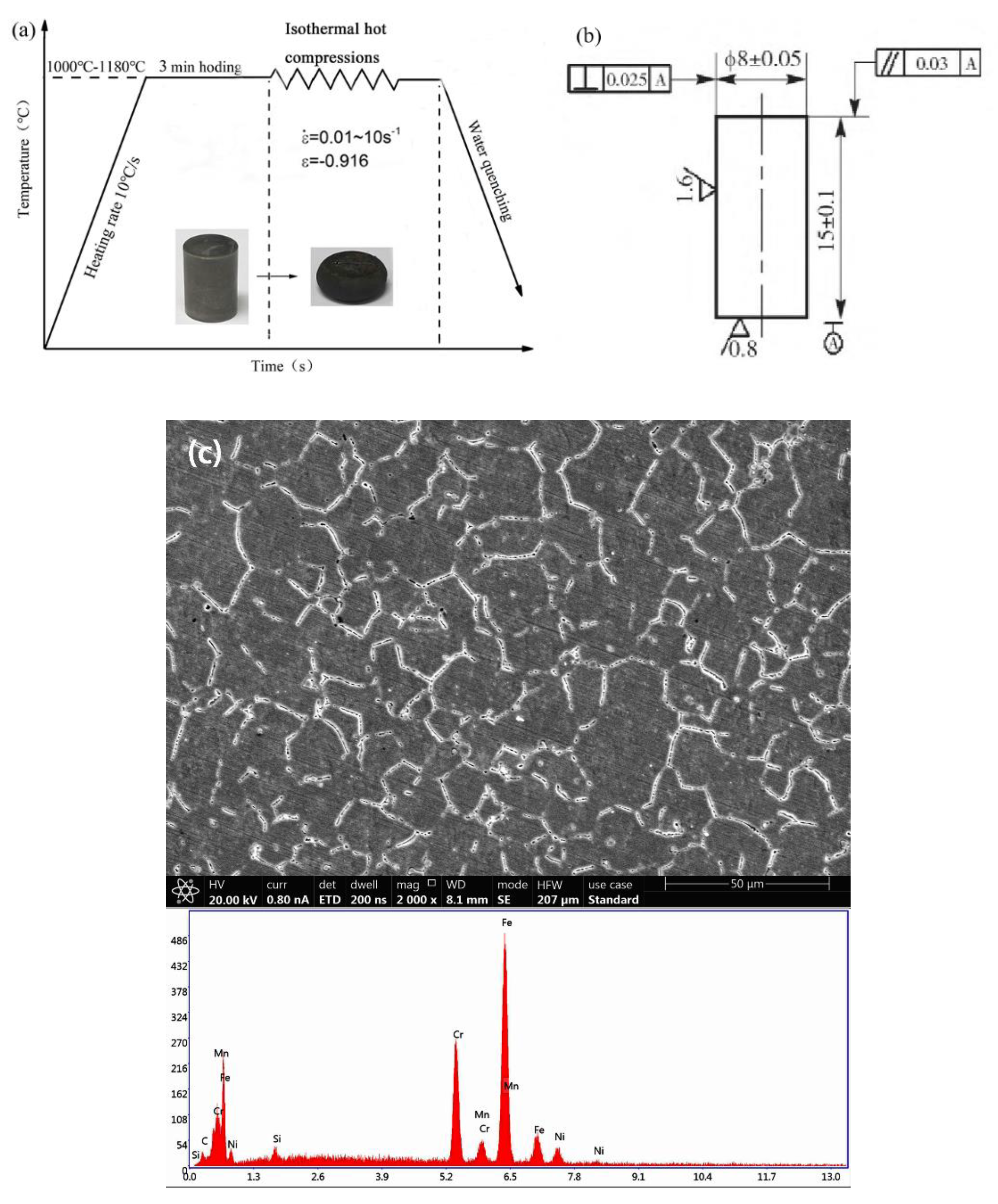


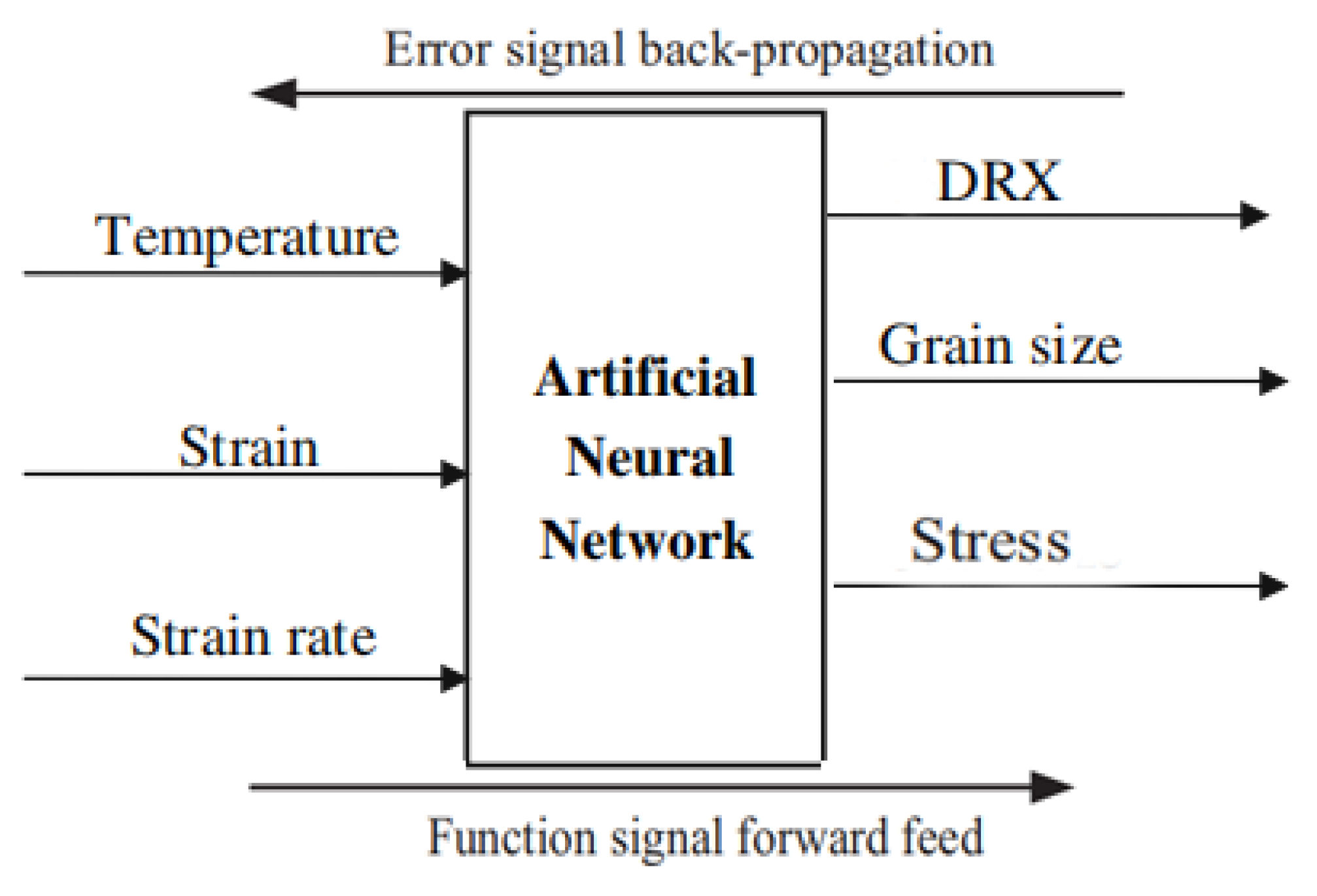
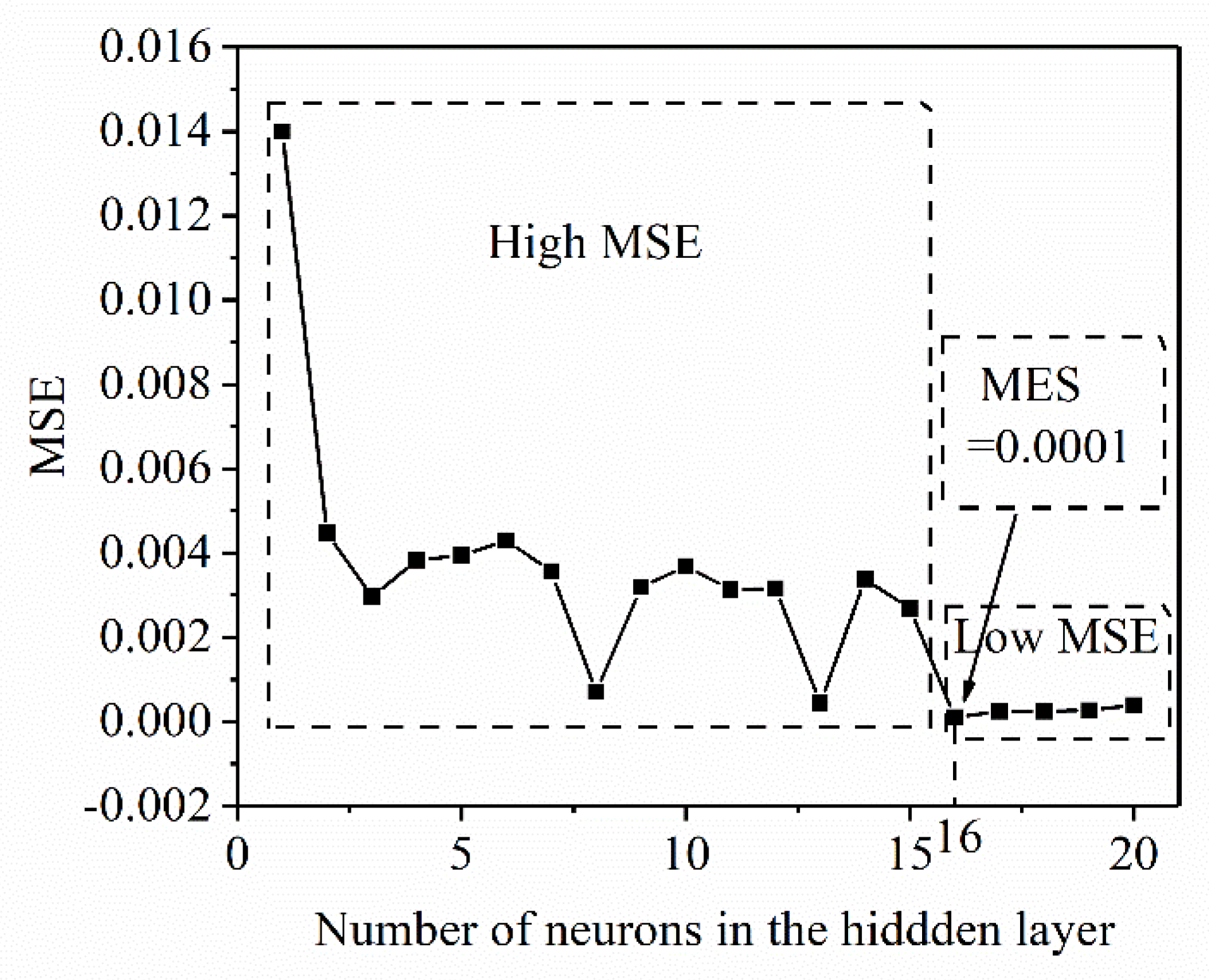
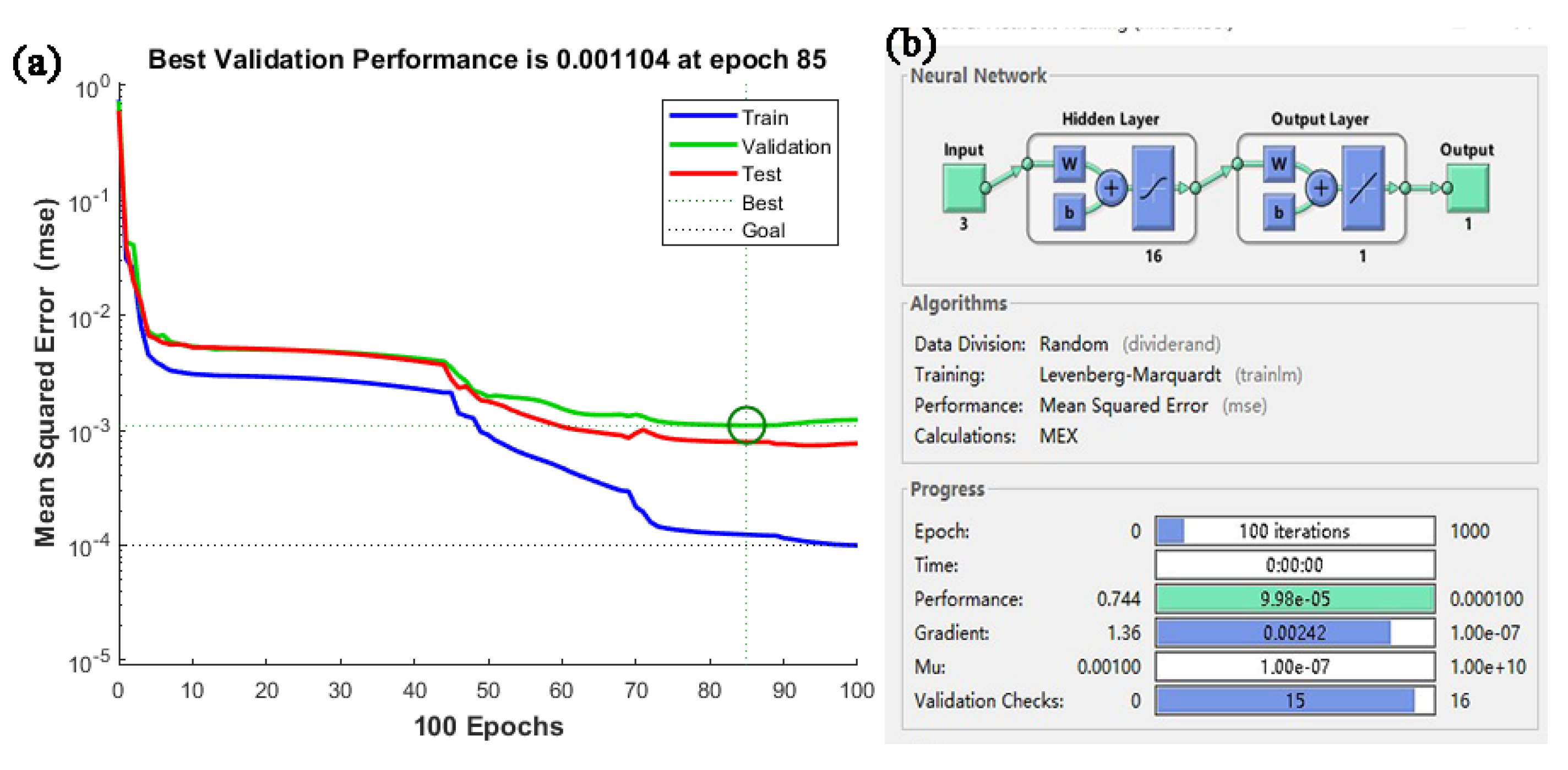
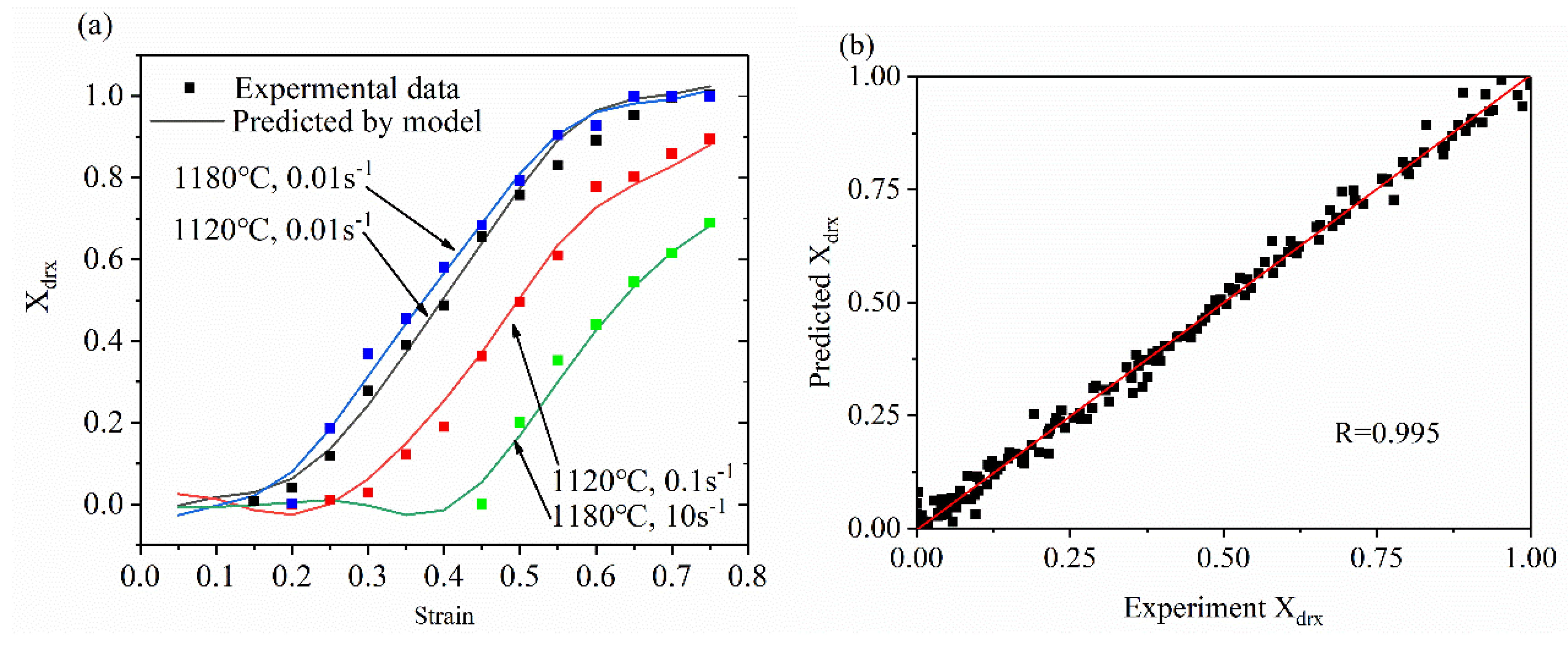

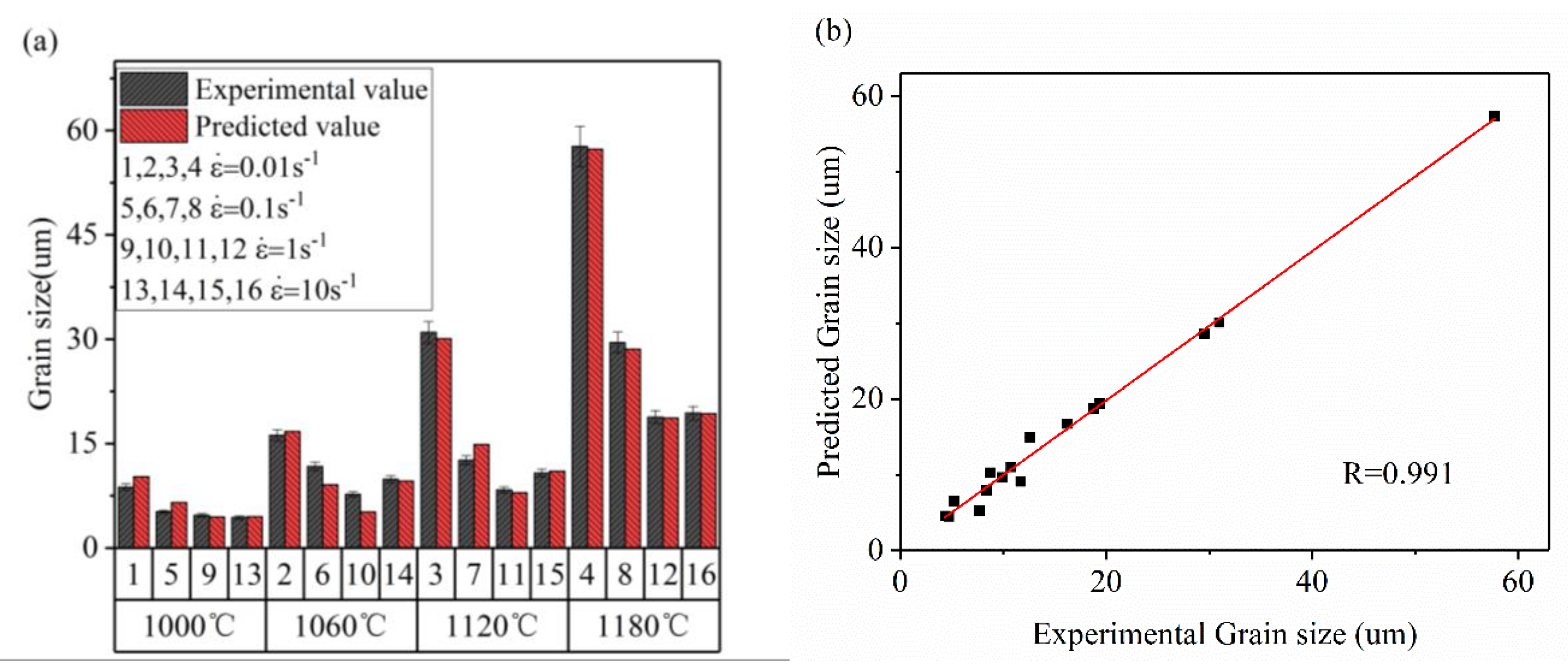

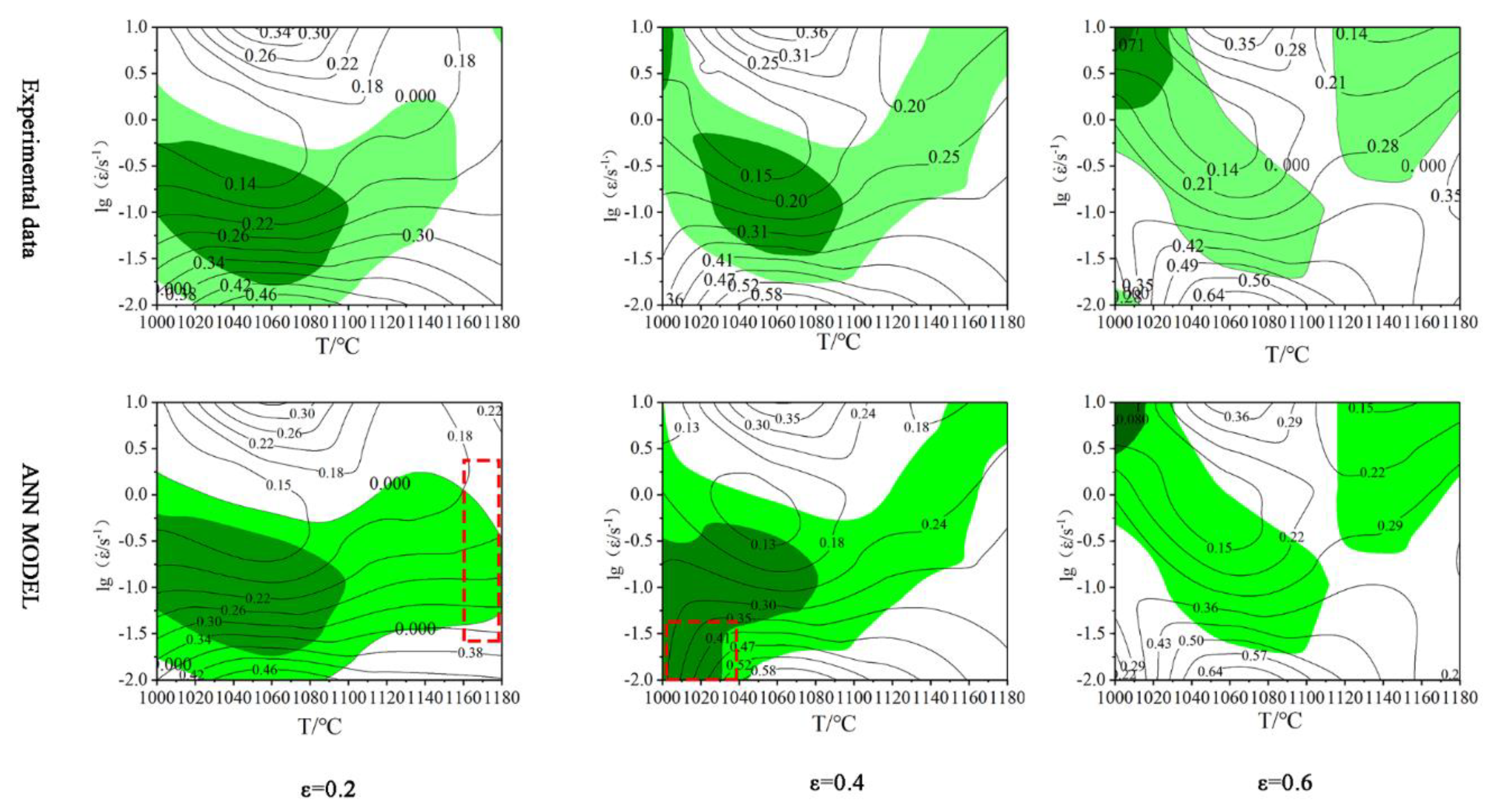
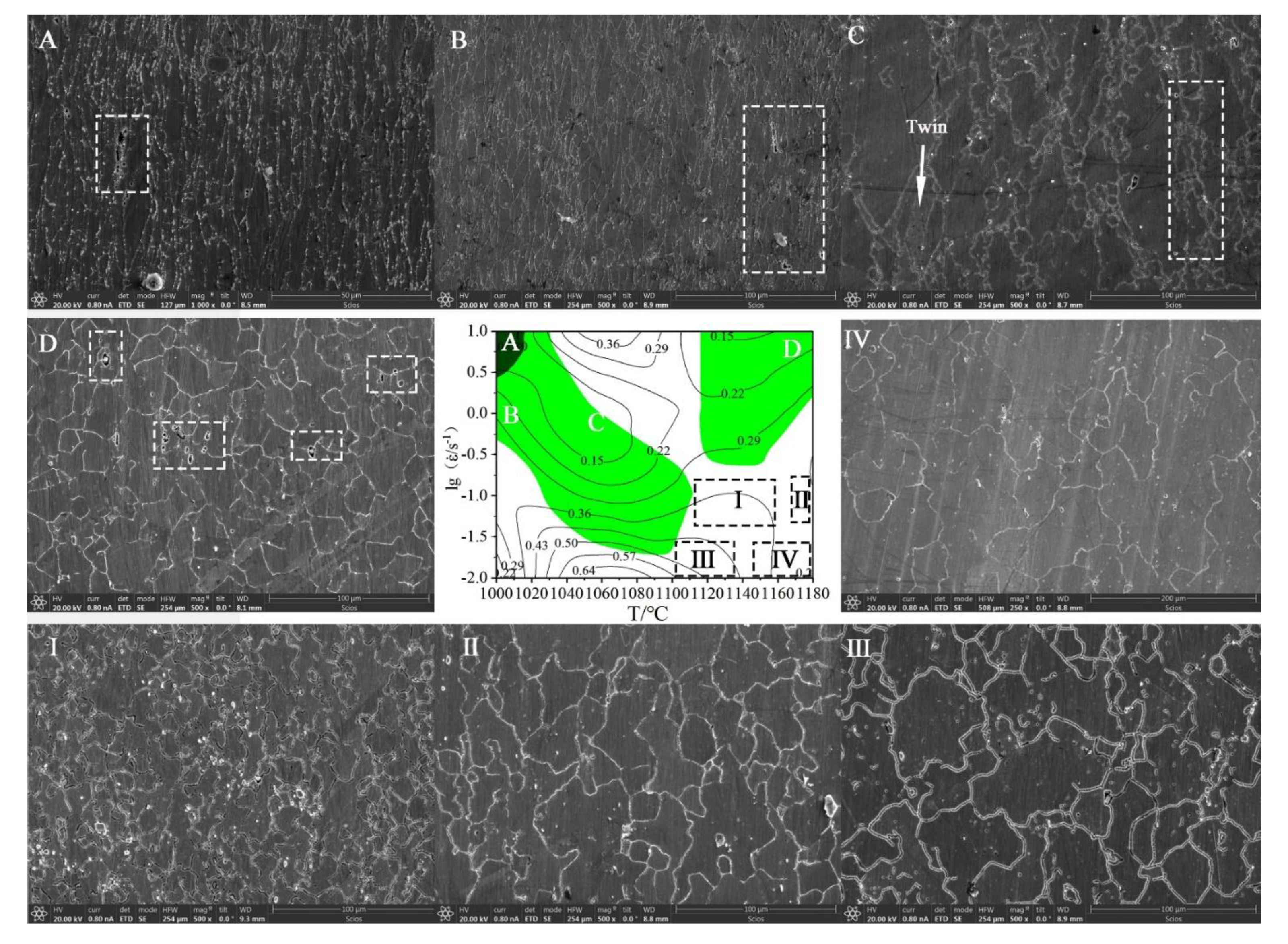

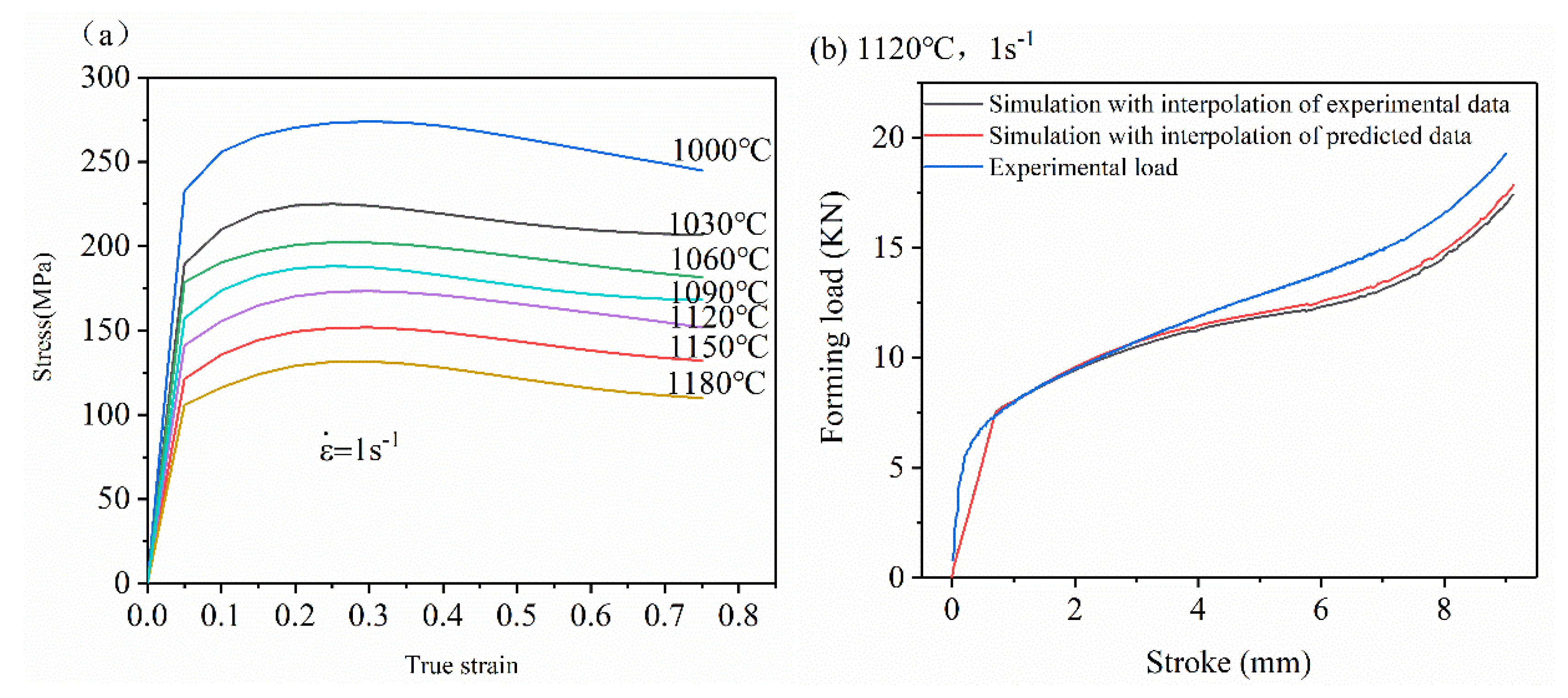
| PARAMETER | CONTENT |
|---|---|
| Neural network type | BACK PROPAGATION |
| Adaption learning function | LEARNGM |
| Training function | TRAINLM |
| Transfer Function (input and hidden layer) | TANSIG |
| Activation Function (hidden layer to output layer) | PURELIN |
| Performance function Training epoch Goal | MSE 1000 10−4 |
© 2020 by the authors. Licensee MDPI, Basel, Switzerland. This article is an open access article distributed under the terms and conditions of the Creative Commons Attribution (CC BY) license (http://creativecommons.org/licenses/by/4.0/).
Share and Cite
Cai, Z.; Ji, H.; Pei, W.; Tang, X.; Xin, L.; Lu, Y.; Li, W. An Investigation into the Dynamic Recrystallization (DRX) Behavior and Processing Map of 33Cr23Ni8Mn3N Based on an Artificial Neural Network (ANN). Materials 2020, 13, 1282. https://doi.org/10.3390/ma13061282
Cai Z, Ji H, Pei W, Tang X, Xin L, Lu Y, Li W. An Investigation into the Dynamic Recrystallization (DRX) Behavior and Processing Map of 33Cr23Ni8Mn3N Based on an Artificial Neural Network (ANN). Materials. 2020; 13(6):1282. https://doi.org/10.3390/ma13061282
Chicago/Turabian StyleCai, Zhongman, Hongchao Ji, Weichi Pei, Xuefeng Tang, Long Xin, Yonghao Lu, and Wangda Li. 2020. "An Investigation into the Dynamic Recrystallization (DRX) Behavior and Processing Map of 33Cr23Ni8Mn3N Based on an Artificial Neural Network (ANN)" Materials 13, no. 6: 1282. https://doi.org/10.3390/ma13061282





